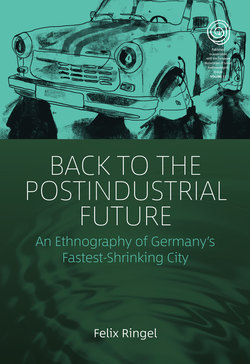Читать книгу Back to the Postindustrial Future - Felix Ringel - Страница 19
На сайте Литреса книга снята с продажи.
Conclusion: Knowledge in Motion
ОглавлениеAs the song mentioned above by Gundermann indicated, the question at the heart of this study is how people relate to the future. Gundermann rightly draws attention to the human agency involved in one’s positioning towards the future. This requires an understanding of knowledge itself being in motion. The ways in which people relate to the future are not fixed and stable. They evolve in (and are reproduced by) everyday practice, in which all things social, political and ethical are at stake. With this in mind, I explore diverse aspects of a more general shift in local reasoning that occurred during my fieldwork in 2008 and 2009, a shift that can loosely be described as one from a postsocialist to a postindustrial temporal framework. I also encountered many moments when both frameworks were overcome. In specific social, cultural, political and educational projects, such moments bear witness to the indeterminateness of human thought, agency and practice, which East Germans and other people affected by decline are so often seen to have lost. This then is a ‘presentist ethnography’, and I see my analysis as an invitation to ponder on the issue of (temporal) knowledge, particularly on its efficacy and its relationship to present hopes and futures.
In the following chapters, I understand ‘knowledge in time’ in three different ways. First, I chart the ways in which knowledge (in terms of content, form and practice) changes over time: new concepts emerge, are negotiated and have particular effects (compare Rabinow 2003, 2007). Second, I consider the temporal dimension of knowledge as the many different ways in which people in their knowledge practices reach out in time to the past or the future, both near and far (compare Guyer 2007). Third, I approach the affective aspects of knowledge practices and according temporal implications, scrutinizing the phenomena of hope and fear and their relations to knowledge about particular temporal dimensions, especially the future (Anderson 2006a, 2006b; Berlant 2011; Povinelli 2011). This does not deploy the concept of temporality as usually attributed to particular objects, forms, relations and situations. Instead of discovering some inherent quality that allows such analytical objects to exist in time, I approach issues of time via the politics that are done with them, the effects they have and their own existence in time (Ringel 2016b).
In this book’s overall structure, one form emerges. First, I analytically zoom in on the theoretical issue of the future in Chapters 1 and 2, laying the groundwork for a more complex understanding of local practices of contextualization and narrativization, and local forms of temporal reasoning, which initially include the past. In Chapters 3 and 4, I investigate two aspects of local futurity more thoroughly. Whereas Chapter 3 enquires into the temporal dimension of the near future regarding conflictive local politics and forms of reasoning, Chapter 4 focuses on affect and affective politics, and their relations to the future. Chapter 5 accompanies the preceding two chapters by zooming out again, that is, proliferating the approach to the future. It presents the issue of maintenance and endurance in consideration of local beliefs in (and hopes for) the efficacy of future knowledge.
Through this explorative strategy, my overall account provides answers to the question posed in Gundermann’s song – by depicting a surprising variety of human relations to the future and bearing witness to a community’s hard work to regain its own sense of the yet-to-come in the conceptual space of the process of shrinkage. This impressive, continuous and multifaceted work stems from the choice that Gundermann had in mind, which motivated my own intellectual engagement with the lives of the inhabitants of Germany’s fastest-shrinking city. Its efficacy is hard to judge, but it keeps my informants going in their diversity towards a future that remains in many ways indeterminate by the past that once was their present. It keeps time, and knowledge about it, in motion.
